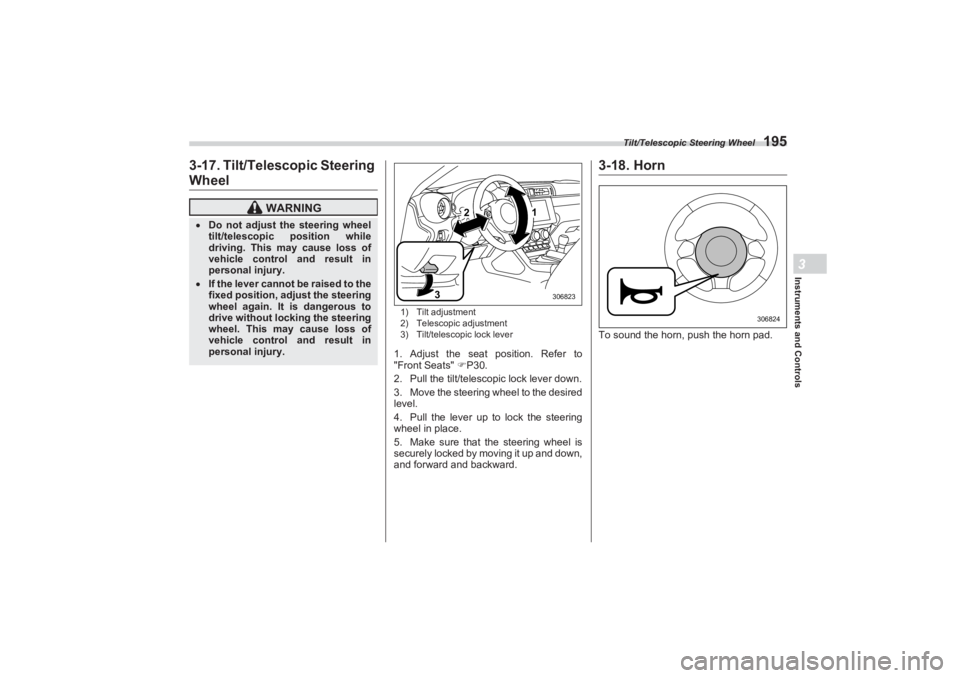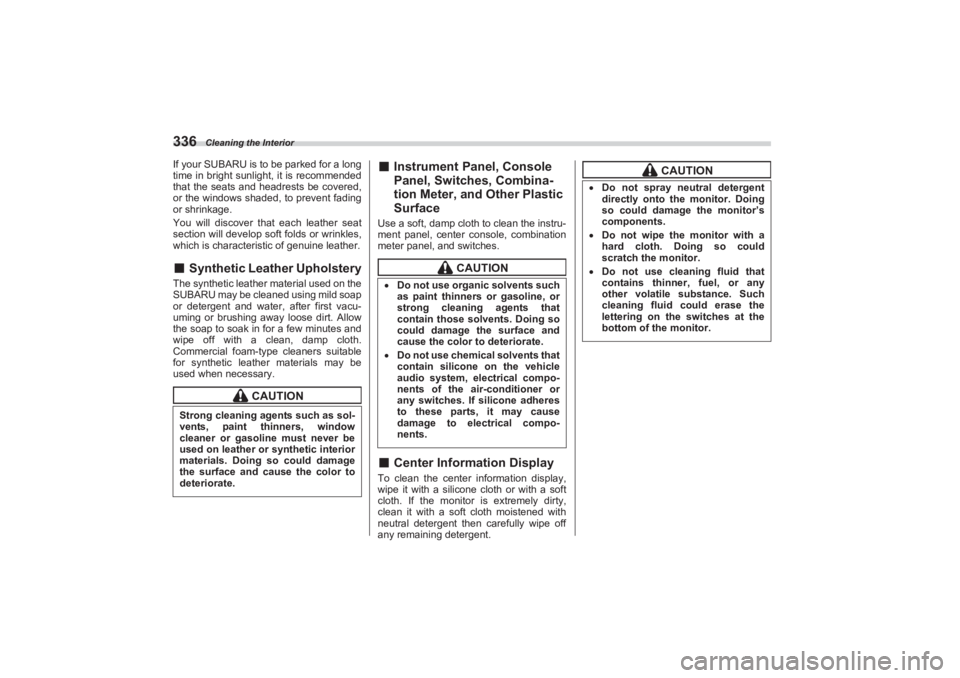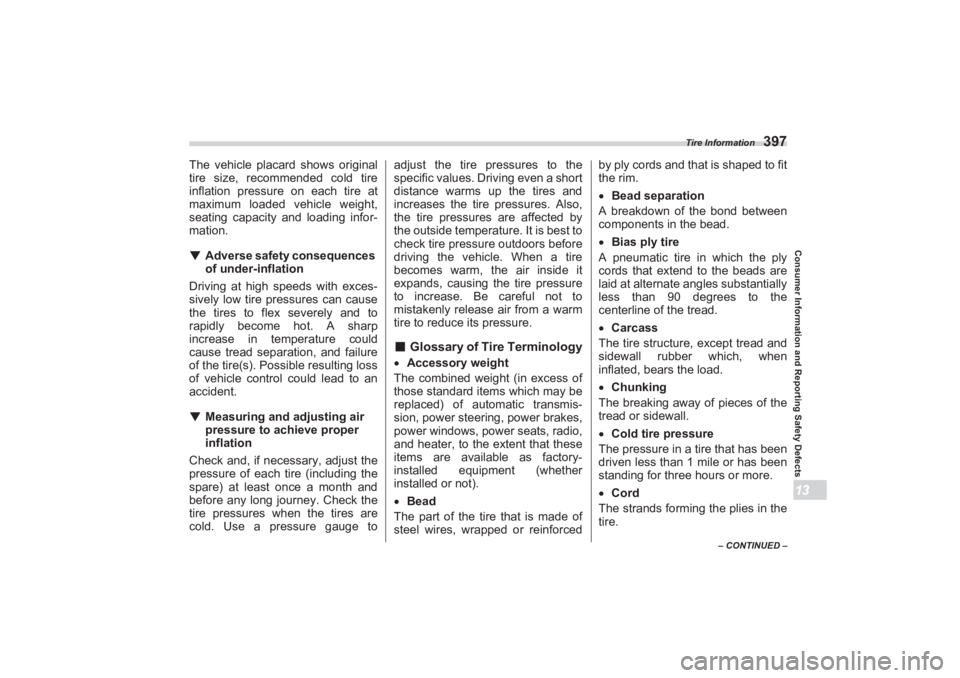2023 SUBARU BRZ seats
[x] Cancel search: seatsPage 201 of 432

Tilt/Telescopic Steering Wheel
195
Instruments and Controls3
3-17. Tilt/Telescopic SteeringWheel
1) Tilt adjustment
2) Telescopic adjustment
3) Tilt/telescopic lock lever1. Adjust the seat position. Refer to
"Front Seats" P30.
2. Pull the tilt/telescopic lock lever down.
3. Move the steering wheel to the desired
level.
4. Pull the lever up to lock the steering
wheel in place.
5. Make sure that the steering wheel is
securely locked by moving it up and down,
and forward and backward.
3-18. HornTo sound the horn, push the horn pad.
WARNING
Do not adjust the steering wheel
tilt/telescopic position while
driving. This may cause loss of
vehicle control and result in
personal injury. If the lever cannot be raised to the
fixed position, adjust the steering
wheel again. It is dangerous to
drive without locking the steering
wheel. This may cause loss of
vehicle control and result in
personal injury.
2
3
1
306823
306824
BRZ_U.book 195 ページ 2022年3月29日 火曜日 午後3時59分
Page 304 of 432

Loading Your Vehicle
298
NOTEFor better fuel economy, do not carry
unneeded cargo.
■ Vehicle Capacity WeightThe load capacity of your vehicle is deter-
mined by weight, not by available cargo
space. The maximum load you can carry
in your vehicle is shown on the tire infla-
tion pressure label attached to the driver’s
side center pillar. It includes the total
Stow cargo and luggage in the
trunk whenever possible. To prevent cargo and luggage
from sliding forward during
braking, do not stack anything in
the enlarged trunk. Keep cargo
and luggage low, as close to the
floor as possible. When you carry something inside
the vehicle, secure it whenever
you can to prevent it from being
thrown around inside the vehicle
during sudden stops, sharp turns
or in an accident. Secure long items properly to
prevent them from shooting
forward and causing serious
injury during a sudden stop. Never exceed the maximum load
limit. If you do, some parts on
your vehicle can break, or it can
change the way your vehicle
handles. This could result in loss
of control and cause personal
injury. Also, overloading can
shorten the life of your vehicle.
Do not place cargo or luggage in
or on the following locations as
the item may get under the clutch,
brake, or accelerator pedal and
prevent the pedals from being
depressed properly, block the
driver’s vision, or hit the driver or
passengers, causing an accident:
- At the feet of the driver- On the front passenger or rear
seats (when stacking items)- On the rear shelf- On the instrument panel- On the dashboard
CAUTION
Do not carry spray cans, containers
with flammable or corrosive liquids
or any other dangerous items inside
the vehicle.
D00250801321
BRZ_U.book 298 ページ 2022年3月29日 火曜日 午後3時59分
Page 342 of 432

Cleaning the Interior
336If your SUBARU is to be parked for a long
time in bright sunlight, it is recommended
that the seats and headrests be covered,
or the windows shaded, to prevent fading
or shrinkage.
You will discover that each leather seat
section will develop so ft folds or wrinkles,
which is characteristic of genuine leather.■ Synthetic Leather UpholsteryThe synthetic leather material used on the
SUBARU may be cleaned using mild soap
or detergent and water, after first vacu-
uming or brushing away loose dirt. Allow
the soap to soak in for a few minutes and
wipe off with a clean, damp cloth.
Commercial foam-type cleaners suitable
for synthetic leather materials may be
used when necessary.
■ Instrument Panel, Console
Panel, Switches, Combina -
tion Meter, and Other Plastic
SurfaceUse a soft, damp cloth to clean the instru-
ment panel, center console, combination
meter panel, and switches.■ Center Information DisplayTo clean the center information display,
wipe it with a silicone cloth or with a soft
cloth. If the monitor is extremely dirty,
clean it with a soft cloth moistened with
neutral detergent then carefully wipe off
any remaining detergent.
CAUTION
Strong cleaning agents such as sol-
vents, paint thinners, window
cleaner or gasoline must never be
used on leather or synthetic interior
materials. Doing so could damage
the surface and cause the color to
deteriorate.
CAUTION
Do not use organic solvents such
as paint thinners or gasoline, or
strong cleaning agents that
contain those solvents. Doing so
could damage the surface and
cause the color to deteriorate. Do not use chemical solvents that
contain silicone on the vehicle
audio system, electrical compo-
nents of the air-conditioner or
any switches. If silicone adheres
to these parts, it may cause
damage to electrical compo-
nents.
CAUTION
Do not spray neutral detergent
directly onto the monitor. Doing
so could damage the monitor’s
components. Do not wipe the monitor with a
hard cloth. Doing so could
scratch the monitor. Do not use cleaning fluid that
contains thinner, fuel, or any
other volatile substance. Such
cleaning fluid could erase the
lettering on the switches at the
bottom of the monitor.
BRZ_U.book 336 ページ 2022年3月29日 火曜日 午後3時59分
Page 403 of 432

Tire Information
397
Consumer Information and Reporting Safety Defects13
– CONTINUED –
The vehicle placard shows original
tire size, recommended cold tire
inflation pressure on each tire at
maximum loaded vehicle weight,
seating capacity and loading infor-
mation.▼ Adverse safety consequences
of under-inflation
Driving at high speeds with exces-
sively low tire pressures can cause
the tires to flex severely and to
rapidly become hot. A sharp
increase in temperature could
cause tread separation, and failure
of the tire(s). Possible resulting loss
of vehicle control could lead to an
accident.
▼ Measuring and adjusting air
pressure to achieve proper
inflation
Check and, if necessary, adjust the
pressure of each tire (including the
spare) at least once a month and
before any long journey. Check the
tire pressures when the tires are
cold. Use a pressure gauge to adjust the tire pressures to the
specific values. Driving even a short
distance warms up the tires and
increases the tire pressures. Also,
the tire pressures are affected by
the outside temperature. It is best to
check tire pressure outdoors before
driving the vehicle. When a tire
becomes warm, t he air inside it
expands, causing the tire pressure
to increase. Be careful not to
mistakenly release air from a warm
tire to reduce its pressure.
■ Glossary of Tire TerminologyAccessory weight
The combined weight (in excess of
those standard items which may be
replaced) of automatic transmis-
sion, power steering, power brakes,
power windows, power seats, radio,
and heater, to the extent that these
items are available as factory-
installed equipment (whether
installed or not).
Bead
The part of the tire that is made of
steel wires, wrapped or reinforced by ply cords and that is shaped to fit
the rim.
Bead separation
A breakdown of the bond between
components in the bead.
Bias ply tire
A pneumatic tire in which the ply
cords that extend to the beads are
laid at alternate an gles substantially
less than 90 degrees to the
centerline of the tread.
Carcass
The tire structure, except tread and
sidewall rubber which, when
inflated, bears the load.
Chunking
The breaking away of pieces of the
tread or sidewall.
Cold tire pressure
The pressure in a tire that has been
driven less than 1 mile or has been
standing for three hours or more.
Cord
The strands forming the plies in the
tire.
BRZ_U.book 397 ページ 2022年3月29日 火曜日 午後3時59分
Page 419 of 432

Index
413
Index14
Driving distance ................................................................... P153
Driving mode select switch .................................................. P241
Driving range ....................................................................... P153
Driving support system setting display ................................ P157
Driving time ......................................................................... P153EElectrical system ................................................................. P385
Electronic Brake Force Distribution (EBD) system .............. P246
Warning........................................................................... P141
Emergency Locking Retractor (ELR ) ..................................... P40
Engine
Compartment overview ................................................... P345
Coolant............ .......................................... ............ P349, P384
Exhaust gas (carbon monoxide) . .............................. P7, P290
Hood ............................................................................... P343
Hood release knob ........ .......................................... ........ P343
Oil............................ ..................................... ......... P346, P381
Overheating .................................................................... P319
Start & stopping ......... ................................................ ..... P229
Engine oil temperature gauge ............................................. P153
Event data recorder ............................................................... P11
Exclusive content for SUBARU BRZ ................................... P154
Exterior care ........................................................................ P332FFlat tire ................................................................................ P303
Flat tire repair kit .................................................................. P309 Technical data of air compressor .................................... P314 Floor mat.............................................................................. P218
Fluid level
Automatic transmission .............. ..................................... P352
Brake ............................................................................... P353
Clutch .............................................................................. P354
Front
Passenger’s frontal airbag ON and OFF ........................... P72
Seatbelt pretensioners ...................................................... P44
Front seats ............................................................................. P30 Forward and backward adjustment ................................... P33
Head restraint adjustment .......... ....................................... P34
Manual seat............... ........................................................ P33
Reclining ........................................................................... P33
Seat heater.......... ........................................................ ...... P35
Seat height adjustment (driver's seat) ............................... P33
Fuel ...................................................................................... P223 Economy hints.............. .................................... ............... P290
Filler door and cap .......................................................... P224
Filler lid and cap .............................................................. P224
Gauge ............................................................................. P129
Requirements .......................... ..............................P223, P381
Tank capacity .................................................................. P381
Fuel consumption Average fuel consumption............................................... P153
Current fuel consumption ................................................ P153
Fuses ................................................................................... P371
GGasoline............................................................................... P223
BRZ_U.book 413 ページ 2022年3月29日 火曜日 午後3時59分